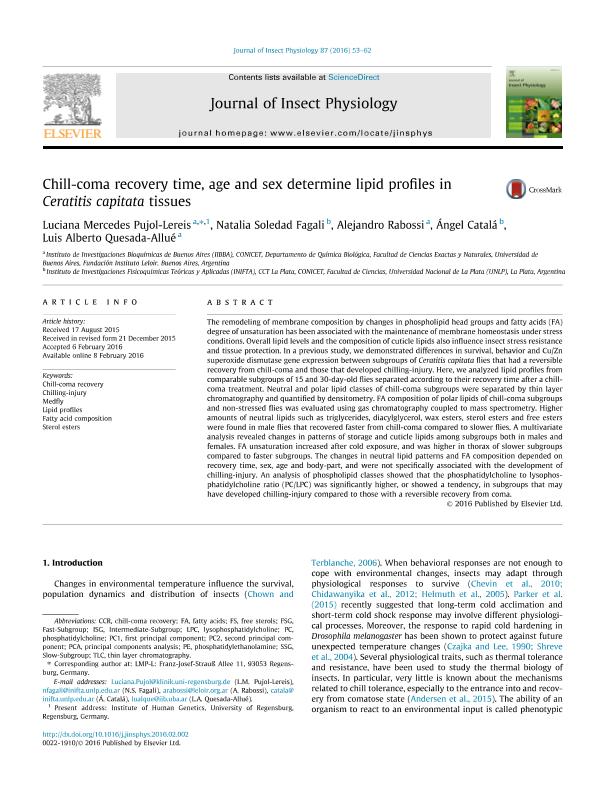Artículo
Chill-coma recovery time, age and sex determine lipid profiles in Ceratitis capitata tissues.
Pujol Lereis, Luciana Mercedes ; Fagali, Natalia Soledad
; Fagali, Natalia Soledad ; Rabossi, Alejandro
; Rabossi, Alejandro ; Catala, Angel
; Catala, Angel ; Quesada Allue, Luis Alberto
; Quesada Allue, Luis Alberto
 ; Fagali, Natalia Soledad
; Fagali, Natalia Soledad ; Rabossi, Alejandro
; Rabossi, Alejandro ; Catala, Angel
; Catala, Angel ; Quesada Allue, Luis Alberto
; Quesada Allue, Luis Alberto
Fecha de publicación:
02/2016
Editorial:
Elsevier
Revista:
Journal of Insect Physiology
ISSN:
0022-1910
e-ISSN:
1879-1611
Idioma:
Inglés
Tipo de recurso:
Artículo publicado
Clasificación temática:
Resumen
The remodeling of membrane composition by changes in phospholipid head groups and fatty acids (FA) degree of unsaturation has been associated with the maintenance of membrane homeostasis under stress conditions. Overall lipid levels and the composition of cuticle lipids also influence insect stress resistance and tissue protection. In a previous study, we demonstrated differences in survival, behavior and Cu/Zn superoxide dismutase gene expression between subgroups of Ceratitis capitata flies that had a reversible recovery from chill-coma and those that developed chilling-injury. Here, we analyzed lipid profiles from comparable subgroups of 15 and 30-day-old flies separated according to their recovery time after a chill-coma treatment. Neutral and polar lipid classes of chill-coma subgroups were separated by thin layer chromatography and quantified by densitometry. FA composition of polar lipids of chill-coma subgroups and non-stressed flies was evaluated using gas chromatography coupled to mass spectrometry. Higher amounts of neutral lipids such as triglycerides, diacylglycerol, wax esters, sterol esters and free esters were found in male flies that recovered faster from chill-coma compared to slower flies. A multivariate analysis revealed changes in patterns of storage and cuticle lipids among subgroups both in males and females. FA unsaturation increased after cold exposure, and was higher in thorax of slower subgroups compared to faster subgroups. The changes in neutral lipid patterns and FA composition depended on recovery time, sex, age and body-part, and were not specifically associated with the development of chilling-injury. An analysis of phospholipid classes showed that the phosphatidylcholine to lysophosphatidylcholine ratio (PC/LPC) was significantly higher, or showed a tendency, in subgroups that may have developed chilling-injury compared to those with a reversible recovery from coma.
Palabras clave:
Chill-Coma
,
Medfly
,
Lipid Profiles
,
Sterol Esters
,
Lipid Profiles
Archivos asociados
Licencia
Identificadores
Colecciones
Articulos(IIBBA)
Articulos de INST.DE INVEST.BIOQUIMICAS DE BS.AS(I)
Articulos de INST.DE INVEST.BIOQUIMICAS DE BS.AS(I)
Articulos(INIFTA)
Articulos de INST.DE INV.FISICOQUIMICAS TEORICAS Y APLIC.
Articulos de INST.DE INV.FISICOQUIMICAS TEORICAS Y APLIC.
Citación
Pujol Lereis, Luciana Mercedes; Fagali, Natalia Soledad; Rabossi, Alejandro; Catala, Angel; Quesada Allue, Luis Alberto; Chill-coma recovery time, age and sex determine lipid profiles in Ceratitis capitata tissues.; Elsevier; Journal of Insect Physiology; 87; 2-2016; 53-62
Compartir
Altmétricas



